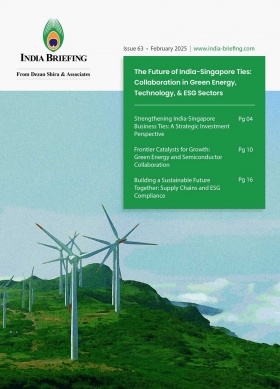India-UK FTA 2025: Strategic Insights for Textile Exporters and Importers
India Briefing examines the transformative impact of the India-UK Free Trade Agreement (FTA) on the textile sector, offering data-driven insights, sectoral forecasts, compliance considerations, and strategic recommendations for Indian manufacturers, exports, and UK-based importers.
The India and the United Kingdom (UK) FTA signed on May 6, 2025, marks a pivotal shift in global textile trade, especially for Indian exporters. The agreement, which addresses various aspects such as pricing, product specifications, regulatory alignment, and trade facilitation, is expected to potentially increase India’s textile and apparel exports to the UK.
READ MORE ON: India-UK FTA Finalized After Three Years of Negotiations
India’s textile exports: Key data and product segments
India is the world’s second-largest exporter of textiles and a major employment generator, providing livelihoods to over 45 million people. The country’s vast and diverse textile industry contributes majorly to its trade portfolio, supported by a wide range of product categories—from raw materials to high-value finished goods.
Snapshot of India’s textile trade for FY 2024–25:
- Exports: US$37,896 million
- Imports: US$9,494 million
Key textile products for exports:
- Handmade carpets (excluding silk)
- Coir and coir products
- Cotton fabrics and made-ups
- Raw cotton, including textile waste
- Cotton yarn
- Jute-based floor coverings
- Handicrafts (excluding handmade carpets)
- Jute hessian
- Raw jute
- Jute yarn
- Manmade staple fibres
- Manmade yarn, fabrics, and made-ups
- Silk yarns, fabrics, and made-ups
- Other textile yarns, fabrics, and made-ups
- Ready-made garments (RMG) of cotton, including accessories
- RMG made from manmade fibres
- RMG made from other textile materials
- RMG made from silk
- RMG made from wool
UK market access for Indian exports
With the UK reshaping its global supply chains post-Brexit and India targeting US$100 billion in textile exports, the FTA offers a timely opportunity for both countries. The terms of agreement provide Indian textile exporters with duty-free access to one of Europe’s largest apparel import markets, enhancing price competitiveness and strengthening supply chain resilience.
|
Top Indian Exports to the UK in FY 2024–25 (US$ Million) |
|
|
Commodity group |
Export value |
|
Textile products |
1,993 |
|
Electronics & software |
1,160 |
|
Pharmaceuticals |
772 |
|
Agricultural products |
579 |
|
Leather goods |
428 |
|
Engineering goods |
129 |
Source: Trade Monitoring Dashboard, Department of Commerce, Government of India
Textile manufacturers gaining edge under India-UK FTA
Prior to the FTA finalization, Indian textile exports to the UK were subject to import duties ranging between 8 percent and 12 percent, depending on the product type and country of origin. The trade agreement now eliminates tariffs on almost all Indian textile and apparel categories, creating a cost advantage for Indian exporters.
|
Product category |
Pre-FTA tariff |
Post-FTA tariff (2025) |
Competitive advantage |
|
Cotton T-shirts |
12% |
0% |
12% cost savings for UK retailers |
|
Home textiles (Bedsheets) |
10% |
0% |
Stronger appeal compared to European Union (EU) suppliers |
|
Ready-made garments (RMG) |
8%, 12% |
0% |
Major boost for Indian SME manufacturers |
|
Synthetic fabrics |
8% |
0% |
Competitive edge to India over Vietnam and Indonesia |
|
Denim apparel |
10%, 12% |
0% |
Improved access to UK high street fashion brands |
Source: Commenda
The removal of import duties has substantially enhanced the price competitiveness of Indian textiles in the UK market, particularly when compared with products from non-FTA countries like China, Vietnam, and Bangladesh. This strategic shift not only boosts India’s export potential to the UK but also positions it more favorably in global supply chains.
According to data from the Observatory of Economic Complexity (OEC), the UK imported textiles worth £21.1 billion (US$28.7 billion) in 2024, making it the country’s ninth-largest import category. The top five sourcing countries for UK textile imports in 2024 were as follows:
- China—£4.3billion (US$5.85 billion)
- Bangladesh—£2.71billion (US$3.68 billion)
- Turkey—£1.48billion (US$2.01 billion)
- Italy—£1.35billion (US$1.83 billion)
- India—£1.25billion (US$1.7 billion)
The FTA is expected to narrow India’s export gap with larger suppliers like China and Bangladesh by leveling the tariff playing field. Indian exporters now have a timely opportunity to expand their market share in one of the world’s most valuable textile import destinations.
Enhancing textile export competitiveness for India
Industry experts believe that the removal of import duties under the FTA improves the price competitiveness of Indian textile products in the UK market. For instance, a pair of yoga leggings that previously retailed for £11.20 (US$15.20)—factoring in a 12 percent import duty—would now cost only £10 (US$13.6) following the elimination of tariffs. This reduction in cost can either help UK retailers maintain better profit margins or enable Indian exporters to win larger orders.
UK consumers increasingly prefer activewear made from high-performance materials. This trend presents an opportunity for Indian manufacturers to diversify into value-added textile segments by adopting innovations like polyester-spandex blends, recycled PET yarns, and antimicrobial finishes.
In addition to tariff relief, the FTA includes trade facilitation measures that, combined with India’s existing compliance with UK and EU regulatory standards, are expected to streamline cross-border transactions and improve ease of business.
The duty-free access also applies to widely exported categories like denim and casual wear. As a result, Indian manufacturers can offer more competitive pricing, which is likely to increase demand and accelerate export growth.
Moreover, the agreement aligns with India’s long-term strategy to establish itself as a global leader in the textile industry.
India-UK FTA: Compliance essentials for textile exporters
To benefit from duty-free access under the India-UK FTA, exporters must obtain a valid Certificate of Origin (CoO) for each consignment. Preferably, this should be a digital certificate issued by a recognized Indian authority.
To qualify under the FTA, exported goods must have at least 40 percent of their value added in India. Basic processes like repackaging or minor finishing work are not considered sufficient.
Moreover, exporters should ensure their products are correctly categorized under the Harmonized System (HS) codes. Any errors in classification may lead to the loss of FTA benefits or even penalties during customs clearance.
Labelling and product standards
Textile products shipped to the UK must meet local regulatory and consumer standards, which include the following:
- Clear labeling of fiber composition
- Proper wash care instructions
- Safety compliance, especially for children’s apparel
Advantages for UK importers and Indian exporters
UK businesses sourcing textiles from India now enjoy zero import tariffs, improving their ability to control pricing and boost profit margins or pass on savings to consumers.
Amid increasing costs in Southeast Asia and US trade tensions with China, India offers a stable and competitively priced alternative for UK importers. The FTA further enhances its appeal as a sourcing location.
For Indian exporters to reap the benefits of the FTA agreement, they must ensure the following:
- Digital CoO integration: Begin early adoption of digital certification systems to avoid customs delays.
- Focus on value-added products: Exporters must prioritize items such as handloom textiles, embroidered garments, and organic-certified fabrics to attract UK consumers.
- Enhance fulfillment logistics: Indian exports can establish warehousing or last-mile delivery partnerships in the UK to reduce lead times and better compete with global suppliers.
Conclusion
The India-UK FTA represents a significant shift in global textile trade dynamics. With almost all Indian textile products now exempt from UK import duties, Indian exporters gain a sharp advantage in both pricing and logistics. For the UK, this opens access to a dependable and ethically produced supply chain outside the EU and China.
(GBP£1 = US$1.36)
About Us
India Briefing is one of five regional publications under the Asia Briefing brand. It is supported by Dezan Shira & Associates, a pan-Asia, multi-disciplinary professional services firm that assists foreign investors throughout Asia, including through offices in Delhi, Mumbai, and Bengaluru in India. Dezan Shira & Associates also maintains offices or has alliance partners assisting foreign investors in China, Hong Kong SAR, Vietnam, Indonesia, Singapore, Malaysia, Mongolia, Dubai (UAE), Japan, South Korea, Nepal, The Philippines, Sri Lanka, Thailand, Italy, Germany, Bangladesh, Australia, United States, and United Kingdom and Ireland.
For a complimentary subscription to India Briefing’s content products, please click here. For support with establishing a business in India or for assistance in analyzing and entering markets, please contact the firm at india@dezshira.com or visit our website at www.dezshira.com.
- Previous Article New EV Scheme Paves Way for Global Auto Majors to Invest in India
- Next Article Relaciones bilaterales y comerciales entre India y Chile en 2025








